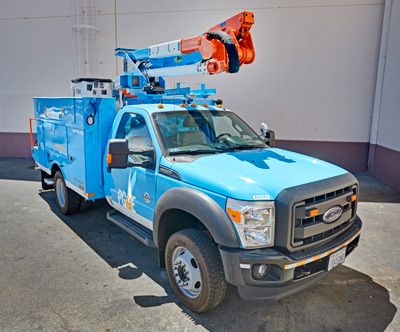
The Rise of ePTO Systems for Utility Trucks
When it comes to electric vehicles (EV), what usually garners headlines are consumer cars, like the Toyota Prius, Nissan LEAF and the eye-catching Tesla Model S sport sedan. But the future expansion of the EV market will likely be driven by commercial fleets, including electric utility companies, which are stepping up investments in all-electric and hybrid-electric vehicles.
In November 2014, the White House and Edison Electric Institute, which represents investor-owned utilities, announced that more than 70 electric utility companies have committed at least 5 percent of their annual fleet acquisition budgets to purchasing plug-in EVs and technologies. This adds up to total investments of approximately $50 million per year, or $250 million over five years, starting in 2015.
According to the White House’s “Fact Sheet: Growing the United States Electric Vehicle Market” (www.whitehouse.gov/the-press-office/2014/11/18/fact-sheet-growing-united-states-electric-vehicle-market), the utility companies expect to meet the 5 percent commitment by purchasing a variety of technologies, from electric passenger cars to medium- and heavy-duty work trucks with electric power take-off (ePTO) systems that power a truck’s onboard equipment – such as aerial platforms and digger derricks – without the need to run the engine.
Traditionally, the power take-off system, which is mounted to the truck’s transmission, redirects engine power to operate onboard equipment. But when you consider that engine idle burns as much as 1 gallon of fuel per hour, a bucket truck that might idle several hours per day wastes a lot of fuel and creates excessive toxic emissions.
That’s why a growing number of utility companies, like Pacific Gas and Electric Co., are expanding their fleets of hybrid-electric trucks equipped with ePTO systems to reduce fuel costs and their carbon footprint. PG&E recently unveiled its plug-in hybrid electric drivetrain Class 5 bucket truck, developed in partnership with Efficient Drivetrains Inc. (EDI) and Altec Industries. The truck features up to 40 miles of all-electric driving and ePTO capabilities that electrify all onboard equipment including the boom, eliminating the need for engine idle at job sites.
PG&E estimates that each plug-in hybrid electric vehicle will reduce emissions by up to 80 percent compared to conventional fuel vehicles and will save the utility more than 850 gallons of fuel per year.
Utility equipment manufacturers Altec Industries (www.altec.com) and Terex Corp. (www.terex.com) both offer hybrid-electric systems with ePTO capabilities for customers.
Dubbed JEMS – for Jobsite Energy Management System – Altec’s hybrid-electric system uses stored electrical energy to power the onboard boom and other equipment, provide exportable power, and generate in-cab heating and cooling, without engine idle. The system’s batteries are charged by plugging into shore power or by operating the truck’s internal combustion engine.
Terex’s hybrid-electric system, called HyPower, also features a plug-in ePTO, harnessing stored energy from rechargeable batteries to power aerial devices and onboard equipment for up to six hours before needing to be recharged. According to the company’s website, Terex estimates that the HyPower saves utility fleets up to 1,500 gallons of fuel per year, based on 7,000 miles and 1,250 job site hours per year.
As utility companies increase their investment in hybrid-electric trucks, they will provide a credible proof of concept about the capabilities of plug-in technologies, setting a compelling example to their commercial fleet customers to follow their lead.
For deeper research, check out “Transportation Electrification: Utility Fleets Leading the Charge” (www.eei.org/issuesandpolicy/electrictransportation/FleetVehicles/Documents/EEI_UtilityFleetsLeadingTheCharge.pdf), a white paper produced by Edison Electric Institute.


